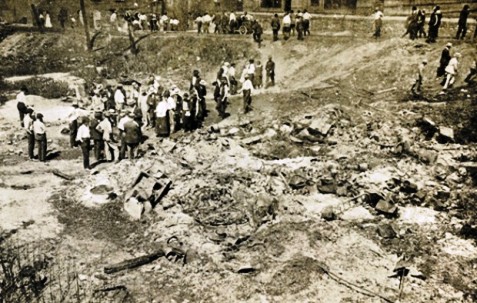

Just before July 4, 1917, the white residents of East St. Louis, Illinois, unleashed a torrent of violence against African Americans. Over two days, the mob terrorized black men, women, and children, sadistically torturing and killing at least thirty-nine, injuring hundreds, and driving thousands more to seek refuge outside the city.
Some recent historians have called it a “pogrom” against African Americans in that civil authorities in the city and the state appear to have been at least complicit in—if not explicitly responsible for—the outbreak of violence. Even in 1917, some commentators already made the comparison between the East St. Louis disturbance and pogroms against Jews that were occurring at the time in Russia.
The violence started on May 28th, 1917, shortly after a city council meeting. Angry white workers lodged formal complaints against black migrations to the Mayor of East St. Louis. After the meeting ended, news of an attempted robbery of a white man by an armed black man began to circulate through the city. As a result of this news, white mobs formed and rampaged through downtown, beating all African Americans who were found.
The mobs also stopped trolleys and streetcars, pulling black passengers out and beating them on the streets and sidewalks. Governor Frank O. Lowden eventually called in the National Guard to quell the violence, and the mobs slowly dispersed. The May 28th disturbances were only a prelude to the violence that erupted on July 2, 1917. Governor Lowden ordered the National Guard out of the city on June 10th, leaving residents of East St. Louis in an uneasy state of high racial tension.

On July 2, 1917, the violence resumed. Roving mobs rampaged through the city for a day and a night, burning the homes and businesses of African Americans, stopping street cars to pull their victims into the street, and assaulting and murdering men, women, and children who they happened to encounter.
A memorial petition to the U.S. Congress, sent by a citizen committee from East St. Louis described it as “a very orgy of inhuman butchery during which more than fifty colored men, women and children were beaten with bludgeons, stoned, shot, drowned, hanged or burned to death—all without any effective interference on the part of the police, sheriff or military authorities.”In fact, estimates of the number of people killed ranged from 40 to more than 150. Six thousand people fled from their homes in the city, either out of fear for their lives or because mobs had burned their houses.
By August of 1917, the United States House of Representatives formed a special Committee investigation of the East St. Louis Race Riots.The definitive findings of the committee revealed gross negligence of the National Guard and the St. Louis police force. They had not, the report said, acted adequately during the riots, revealing that the police often fled from the scenes of murder and arson. Others had deserted the station houses and refused to answer calls for help.

